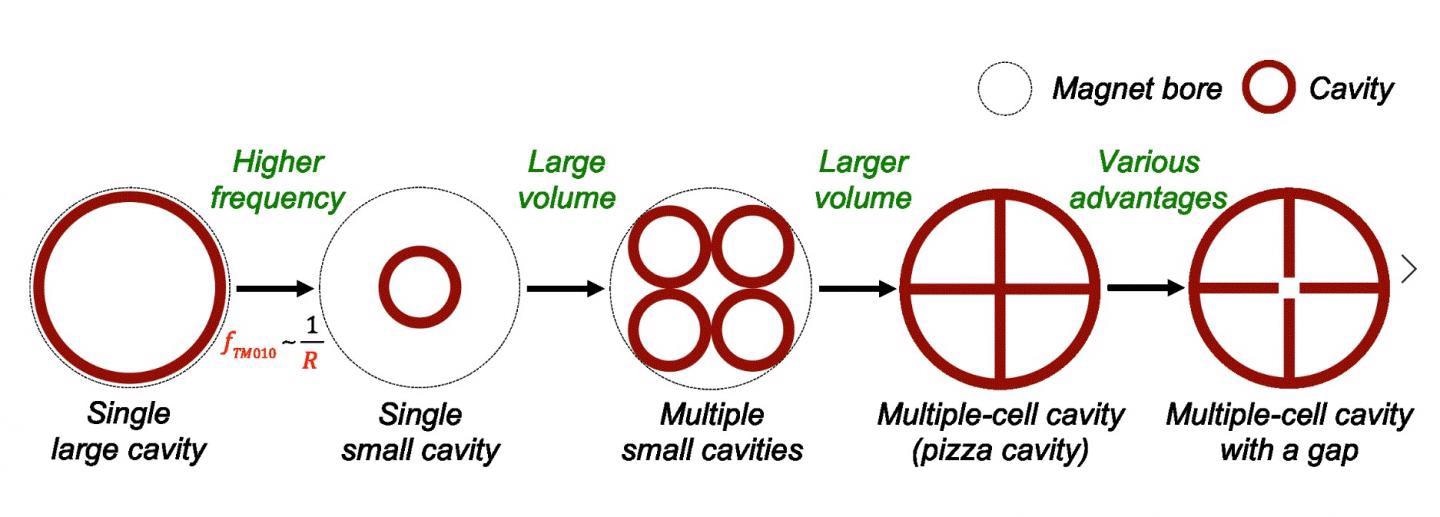Dec 14 2020
Although the axion has a negligibly tiny mass, its existence, which was proven once, might signify new physics beyond the Standard Model.
 Cavity designs with various internal sections. (Left to right) (1) single large cavity, (2) single small cavity, (3) multiple small cavities, (4) multiple-cell cavity (pizza cavity), and (5) multiple-cell cavity with a gap. Image Credit: Institute for Basic Science.
Cavity designs with various internal sections. (Left to right) (1) single large cavity, (2) single small cavity, (3) multiple small cavities, (4) multiple-cell cavity (pizza cavity), and (5) multiple-cell cavity with a gap. Image Credit: Institute for Basic Science.
The hypothetical particle axion emerged to offer a solution for a fundamental symmetry problem in the strong nuclear force related to the imbalance between matter and antimatter in the Universe, but it is also a viable dark matter candidate. Axions might occur in sufficiently huge numbers to be make up for the 'missing' mass from the Universe, but the search for this dark matter has been very difficult thus far.
Researchers consider that during the interaction of an axion with a magnetic field, its energy would be transformed into a photon. The ensuing photon is anticipated to be somewhere in the microwave-frequency range. With the aim of hitting the accurate match for the axion, experimentalists employ a microwave detector—a cavity haloscope.
When a cylindrical resonator is positioned in a solenoid, the magnetic field that fills the cavity improves the signal. Moreover, the haloscope enables researchers to continually tweak the cavity’s resonant frequency.
But the Axion Dark Matter eXperiment (ADMX)—the most sensitive experiment to search for axions—at the University of Washington has been analyzing low-frequency regions, less than 1 GHz. This is because a smaller cavity radius is required to scan regions of higher frequency, leading to a considerable loss in volume and thus weak signal.
Led by Dr SungWoo Youn from the Center for Axion and Precision Physics Research (CAPP) at the Institute for Basic Science (IBS) in South Korea, a team of researchers has created an innovative multiple-cell cavity design, named 'pizza cavity.'
Quite similar to how pizzas are cut into multiple slices, the cavity volume is vertically divided into identical pieces, or cells, by several partitions. With virtually no volume to be lost, this multiple-cell haloscope allows the meaningful output of scanning the high-frequency region.
There have been efforts to bundle together smaller cavities and integrate individual signals with all the cavities tuned at the same frequency, but its complex setup and non-trivial frequency matching mechanism have been hurdles.
The pizza cavity haloscope features a simpler detector setup and a unique phase-matching mechanism as well as a larger detection volume compared to the conventional multi-cavity design.
Dr SungWoo Youn, Study Corresponding Author, Institute for Basic Science
The team demonstrated that the multiple-cell cavity could detect high-frequency signals with higher reliability and efficiency.
The researchers performed an experiment with a 9T-superconducting magnet at a temperature of 2 K, or −271 °C, thus quickly scanning a frequency range of >200 MHz beyond 3 GHz, a region which is approximately four to five times higher compared to ADMX that yielded higher sensitivity to theoretical models than the results achieved by other previous experiments.
Thanks to the new cavity design, the researchers could explore a specified frequency range four times quicker compared to a traditional experiment.
Getting things done four times faster. Using this multiple-cell cavity design, our Ph.D. students should be able to graduate faster than those in other labs.
Dr SungWoo Youn, Study Corresponding Author, Institute for Basic Science
The gap between partitions in the middle renders the new multi-cell design simple to operate. With all the cells connected spatially, a single antenna picks up the signal from the whole volume.
“As a pizza saver keeps pizza slices intact with its original toppings, the gap in between helps the cells to be up to the job,” noted Dr Youn. Moreover, the single antenna enables researchers to evaluate whether the axion-induced electromagnetic fields are distributed evenly through the entire cavity, which is crucial to realize the maximum effective volume.
Still, the inaccuracy and misalignment in cavity construction could hamper the sensitivity. For that, this multiple-cell design enables to relieve it by adjusting the size of the gap in the middle, leaving no volume to go to waste.
Dr SungWoo Youn, Study Corresponding Author, Institute for Basic Science
The two-year comprehensive efforts of the researchers led to an ideal design for the long-standing search for axion dark matter in high-frequency regions. The researchers are now seeking to integrate numerous multi-cell cavities onto the prevalent systems at CAPP to widen the axion search band to regions of higher frequency than those explored at present.
Journal Reference:
Jeong, J., et al. (2020) Search for Invisible Axion Dark Matter with a Multiple-Cell Haloscope. Physical Review Letters. doi.org/10.1103/PhysRevLett.125.221302.